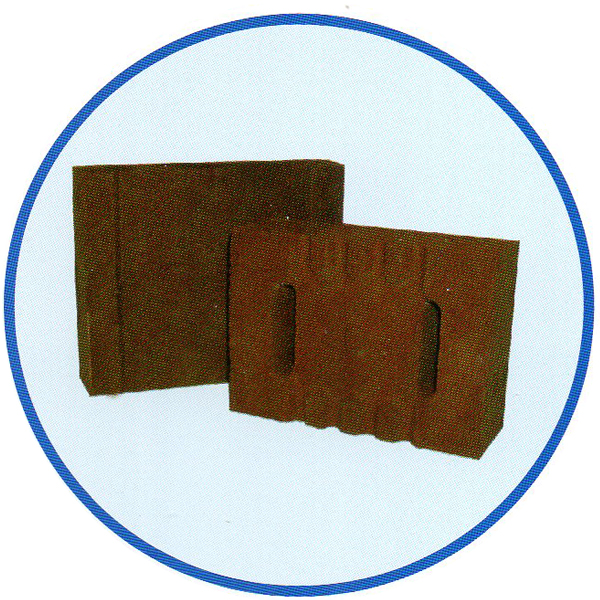The application of magnesia-carbon bricks in converters. Magnesium-carbon bricks for converters are a new type of refractory that was successfully developed by Japan's Jiuzhou Refractories Company Akira Watanabe in the 1970s. Because this kind of carbon-containing refractory product has the advantages of high refractoriness, good slag resistance, heat resistance and low temperature creep, etc., it is widely used in electric furnaces, converters and refining furnaces, and its service life is greatly improved. At the same time, magnesia-carbon bricks do not need high-temperature firing, save energy, and have simple manufacturing processes, so they are quickly promoted and applied in Japan and even many countries. my country began to develop magnesia-carbon bricks in the early 1980s. After small batches of electric furnaces and refining furnaces, they have received better results. Subsequently, Anshan Iron and Steel's No. 3 Steelmaking Plant, Wuhan Iron and Steel's No. 2 Steelmaking Plant, and steel plants successively tested magnesia carbon bricks on large and medium-sized converters, and the age of the converters was greatly improved. Among them, Anshan Iron and Steel No. 3 Steelmaking Co., Ltd. used magnesia-carbon bricks in the converter, and it took one year to overfulfill the "Seventh Five-Year" converter age of 1,000 times. The steelmaking plant of Benxi Iron and Steel began to use magnesia-carbon bricks on the 120t converter in the 1990s. The first test increased the converter life from 700 to more than 1,000. Since then, as the grades of magnesia-carbon bricks continue to increase, the converter furnace age has also increased significantly. By 2003, the converter furnace age of Benxi Iron and Steel had reached ten thousand times, which was close to the domestic advanced level, laying a foundation for reducing steelmaking costs. 1. Development and production of magnesia carbon bricks 1.1 Selection of raw materials, research and practice show that the quality and performance of raw materials have a greater impact on the use of magnesia carbon bricks. Therefore, various raw materials are strictly selected. 1.1.1 The choice of magnesia, which is the main raw material for the production of magnesia carbon bricks. To ensure the quality requirements of magnesia-carbon bricks, low-impurity, high-purity, electric furnace remelted magnesia with well-developed crystals should be selected. Magnesium oxide powder manufacturers

The corrosion loss of magnesia particles during use of converter magnesia carbon bricks is roughly as follows: ①The solid phase reaction between periclase particles and graphite is as follows: MgO+C→Mg↑+CO↑ CO volatilizes; ②The periclase particles are chemically melted by the slag, including various oxides in foreign slag and magnesia impurities; ③After the matrix of the magnesia carbon brick working layer is oxidized and decarburized, its bonding strength decreases. Under the penetration and erosion of the slag, the periclase particles break away from the brick body and are washed into the slag. After fully considering the above factors, the magnesia-carbon bricks used use magnesia with high magnesia content with large periclase crystal grains, strong binding force and few impurities as the main raw material. This magnesia cannot reduce the periclase crystals. The degree of separation by the silicate phase reduces the erosion rate of the slag on the grain boundary, and can also improve the stability of the coexistence of magnesia and graphite at high temperatures. In addition, due to its high bulk density and strong binding force, particles with sharp edges and corners can be obtained during the processing of magnesia, which strengthens the inlay combination with the matrix and improves the stability of the magnesia particles in the magnesia carbon brick. Compared with sintered magnesia, fused magnesia has the advantages of coarse periclase crystal grains and large particle volume density. It is the main raw material used in magnesia carbon bricks. Considering the use effect and cost, various grades of fused magnesia are selected according to different proportions for the special-shaped magnesia carbon bricks used.
The particle ratio of magnesia also has a greater impact on the use effect of magnesia carbon bricks for converters. Coarse particles as aggregates occupies a large proportion in the ingredients, and the determination of the critical size has a more important impact on the physical properties of the brick. After years of practice, the magnesia-carbon bricks used have selected the appropriate critical particle size and ratio of coarse particles. The matrix part of the magnesia carbon brick is composed of fine magnesia powder and graphite, and its grade has a great influence on the performance of the brick. After many adjustments, the matrix component of the magnesia carbon brick used under the conditions of this steel was selected. 1.1.2 The choice of carbon material and the way of adding it. Carbon materials are also the main raw materials for the production of magnesia carbon bricks. There are many types. The magnesia carbon bricks used by Benxi Iron and Steel select natural flake graphite. The melting point of natural flake graphite is 3700℃. It has a typical lamellar structure, high thermal conductivity, low expansion coefficient and elastic modulus. It is an ideal carbon material for the production of magnesia carbon bricks. The higher the purity of graphite and the thicker the scales, the better the oxidation resistance. The higher the high temperature weight loss, the higher the price. Therefore, the magnesia carbon bricks used by Benxi Iron and Steel will comprehensively consider the use effect and cost when choosing graphite. 1.1.3 The selection of bonding agent, which is the key material for the production of magnesia carbon bricks, should meet the following conditions:
① It can maintain proper viscosity and fluidity at room temperature, has good wettability and affinity for magnesia and graphite, and does not produce age-hardening;
② It can be further polymerized during the heat treatment process, so that the product has higher strength;
③It should have high residual carbon during the heating process and polymerize with other carbon materials to make the product have good high temperature performance;
④ Stable performance.
According to the above requirements, after repeated practice, the thermoplastic phenolic resin bond is selected as the bond for the production of magnesia carbon bricks. 1.1.4 The selection of metal additives, the oxidative decarburization of magnesia carbon bricks is an important cause of its corrosion. After decarburization of magnesia-carbon bricks, the matrix is loose, the bonding strength is reduced, the slag is penetrated and melted, and the magnesia aggregate falls off. Adding some metal powders with greater affinity to oxygen than carbon to magnesia carbon bricks can greatly improve the oxidation resistance and high temperature strength of magnesia carbon bricks. However, due to the high price of various metal additives, it is necessary to take into account the cost and use effect when selecting.
Yingkou Dingfeng Metallurgical Technology Co., Ltd.
18041722333
Contact: Mr. Zhang
Telephone: 18041722333
Mail box: 810678900@qq.com
Address: Liangjunzhai Village, Yong'an Town, Dashiqiao City, Yingkou City, Liaoning Province

QR code